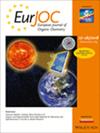叠氮- Ugi和Ugi串联反应合成啉- 2,5 -二酮
IF 2.7
3区 化学
Q2 CHEMISTRY, ORGANIC
引用次数: 0
摘要
含有四唑基团的3,4 -二取代啉- 2,5 -二酮是叠氮- Ugi和Ugi反应串联组合的意外产物。在许多情况下,根本没有观察到经典产物——乌吉双酰胺的形成。当使用最简单的C1‐C3脂肪醛并控制反应条件时,它们的分离是可能的。然而,当使用丁醛和戊醛以及对取代苯甲醛时,只能分离到Ugi转化后的产物,即morpholine - 2,5 - diones。后者可以由相应的Ugi双酰胺通过后Ugi转化顺序合成,也可以在一锅过程中长时间搅拌α -氨基甲基四唑、醛、一氯乙酸和异氰化物四种组分的反应混合物。通过一种新的方法获得了含有四唑片段的15个morpholine - 2,5 - diones的小目标文库。此外,这些化合物能够在酸的存在下从四唑氮中消除N -叔丁基,形成相应的NH -未取代的啉- 2,5 -二酮的四唑衍生物。本文章由计算机程序翻译,如有差异,请以英文原文为准。


Synthesis of Morpholine‐2,5‐Diones by Tandem of Azido‐Ugi and Ugi Reactions
3,4‐Disubstituted morpholine‐2,5‐diones containing a tetrazole moiety are unexpected products of a tandem combination of azido‐Ugi and Ugi reactions. The formation of the classical products – Ugi bisamides – is not observed at all in many cases. When the simplest C1‐C3 aliphatic aldehydes are used and the reaction conditions are controlled, their isolation is possible. However, when butanal and pentanal as well as para‐substituted benzaldehydes are used, only products of post‐Ugi transformations, morpholine‐2,5‐diones, can be isolated. The latter can be synthesized either sequentially from the corresponding Ugi bisamides by post‐Ugi transformation or in a one‐pot procedure with prolonged stirring of the reaction mixture of four components–α‐aminomethyltetrazole, aldehyde, monochloroacetic acid, and isocyanide. A small targeted library of 15 morpholine‐2,5‐diones containing a tetrazole moiety is obtained by a novel approach. Furthermore, these compounds are able to eliminate the N‐tert‐butyl group from the tetrazole nitrogen in the presence of acid to form the corresponding NH‐unsubstituted tetrazole derivatives of morpholine‐2,5‐diones.
求助全文
通过发布文献求助,成功后即可免费获取论文全文。
去求助
来源期刊
CiteScore
5.40
自引率
3.60%
发文量
752
审稿时长
1 months
期刊介绍:
The European Journal of Organic Chemistry (2019 ISI Impact Factor 2.889) publishes Full Papers, Communications, and Minireviews from the entire spectrum of synthetic organic, bioorganic and physical-organic chemistry. It is published on behalf of Chemistry Europe, an association of 16 European chemical societies.
The following journals have been merged to form two leading journals, the European Journal of Organic Chemistry and the European Journal of Inorganic Chemistry:
Liebigs Annalen
Bulletin des Sociétés Chimiques Belges
Bulletin de la Société Chimique de France
Gazzetta Chimica Italiana
Recueil des Travaux Chimiques des Pays-Bas
Anales de Química
Chimika Chronika
Revista Portuguesa de Química
ACH—Models in Chemistry
Polish Journal of Chemistry.

 求助内容:
求助内容: 应助结果提醒方式:
应助结果提醒方式:


